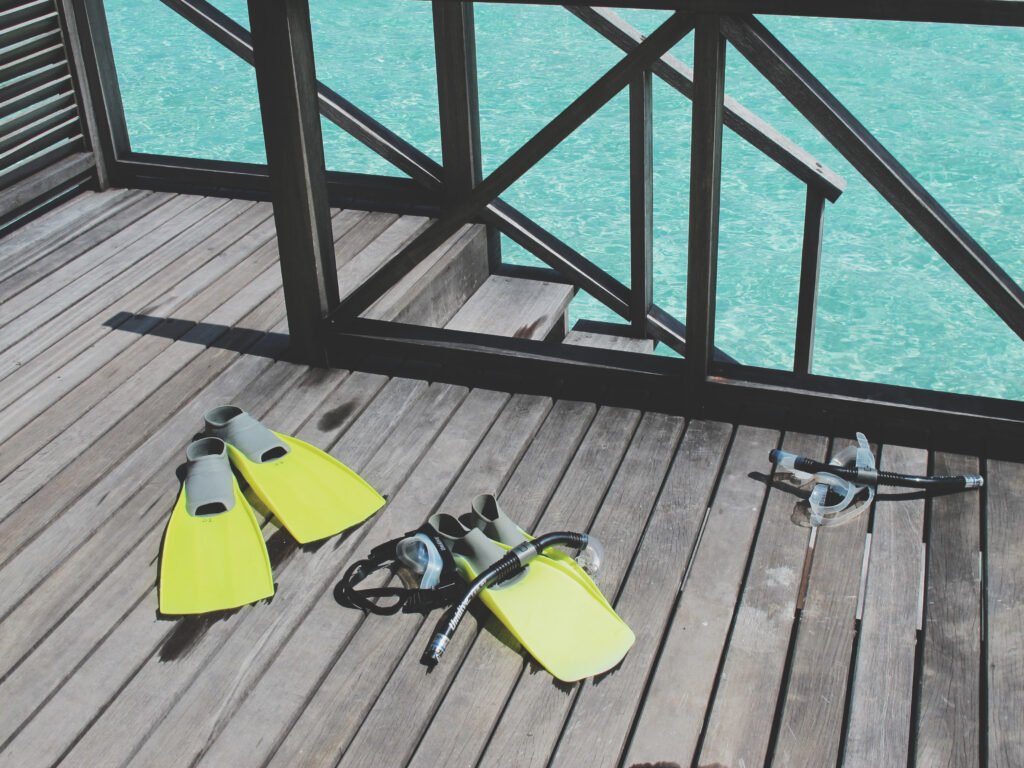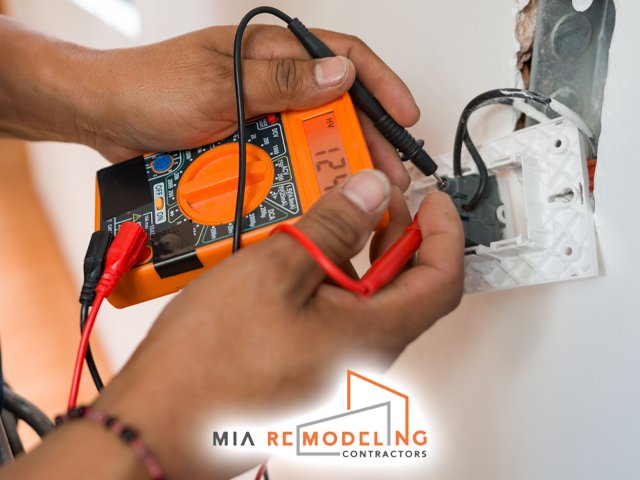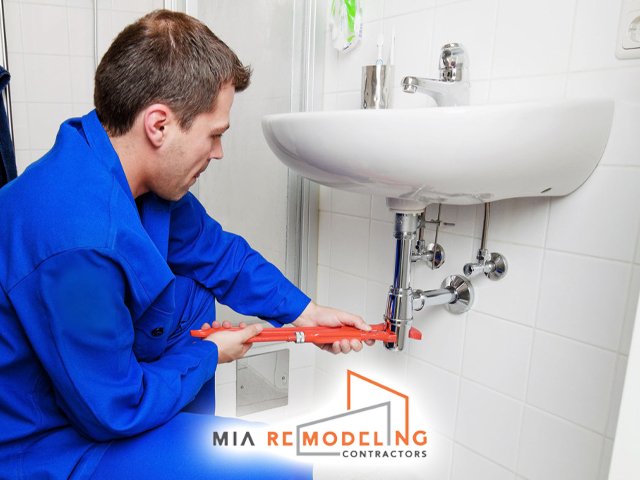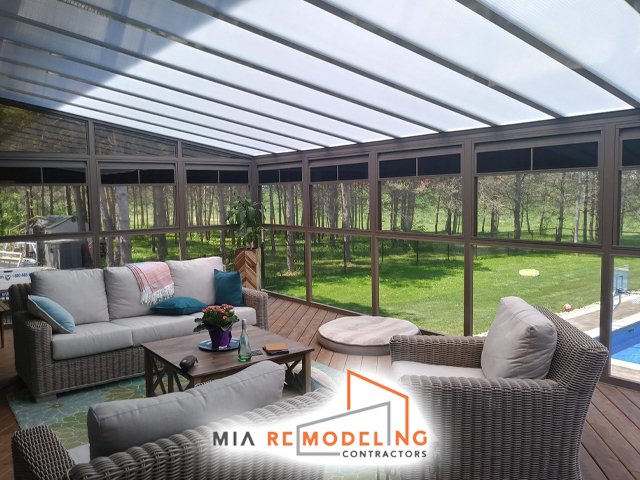Want a safer pool deck without losing the fun? Three smart picks stand out. Broom-finished concrete, textured pavers, and rubber overlays. All three help feet grip when wet. Each has trade-offs for Miami Beach heat, rain, and salty air. Pick based on your deck condition, style, and how you use the space. Let’s break it down so you feel steady on your feet.
Why pool decks get slick in Miami Beach
Water is only part of the story. Sunscreen, salt, and fine sand can turn a smooth deck into a slip trap. Algae likes shade and standing water. Bare concrete with a steel-trowel finish feels like an ice rink when wet. Porcelain with a shiny face can be tricky too. Add our coastal weather, and the surface needs a plan.
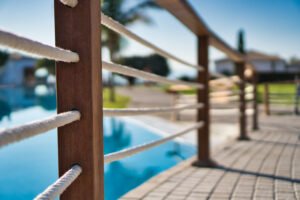
A quick word on the Miami Beach climate
Hot sun cooks the deck most days. Afternoon storms dump water fast. Wind blows sand from the beach onto pavers and concrete. Salt air hangs around near Collins Avenue, Pine Tree Drive, and North Bay Road. UV light beats on pigment and sealers. Materials that grip and shed water do better here.
Option 1: Broom-finished concrete
What it is
Fresh concrete is poured, floated, then brushed with a stiff broom before it cures. The brush leaves tiny ridges. Those ridges catch your bare feet and add traction.
Why it helps
The texture raises many small edges. Water can sit there, but your foot still finds bite. It is simple, tough, and easy to rinse.
Pros
- Reliable grip when wet. That crisscross scratch pattern acts like tiny rain tires.
- Works for new pours or as a resurface with a thin cement coating that gets broomed.
- Easy to clean with a hose and a gentle cleaner.
- Can be tinted for light, cool tones that reflect sun.
Cons
- Rougher on tender feet than other options if the brush lines are too sharp.
- In strong sun, dark colors heat up. Lighter shades stay cooler.
- Without joints and drainage, cracks and puddles can show up.
- If sealed with a glossy film, it may get slick. Use a matte non-slip sealer.
Best matches
- Families who like low fuss care.
- Rental properties that need steady traction.
- Large decks where a simple look fits the home.
Miami Beach tips
- Pick a light sand or shell color to cut heat. On a July day in Mid-Beach, your soles will thank you.
- Ask for a medium broom texture. Not too sharp, not too soft. Think goldilocks grit.
- Add a grit non-slip additive to sealer for extra bite without sandpaper feet.
- Keep good drainage. A gentle slope away from the pool helps water move.
- Rinse after big storms. Salt film can change grip.
Common upgrades
- Saw-cut joints that control cracking.
- Border strip with a finer broom for looks.
- Cool decking coatings made to reflect heat.
Option 2: Textured pavers
What they are
Concrete or stone units set on compact base. Joints are sand or modern joint sand that locks in. The paver face has texture from the mold, tumbling, or a special grit.
Why they help
The surface is not slick. Joints also give tiny breaks where water falls through. Feet meet edges and bumps, which adds traction.
Pros
- Strong grip with the right face. Tumbled or shot-textured faces work well near water.
- Easy to fix a single unit if a chip or stain shows up.
- Great drainage through joints. Less standing water means less algae.
- Many patterns and sizes to match modern or classic homes.
- If the base is built right, they stay even and solid.
Cons
- Sand can wash from joints in heavy rain unless you use a binding joint sand.
- Weeds and ants like open joints if not maintained.
- Very smooth porcelain pavers can be slick when wet. Pick a slip rating that suits pool decks.
- Edges may snag toes if a unit sits high. Keep the field even.
Best matches
- Homes that want a clean look and quick fixes down the road.
- Coastal spots near the beach where drainage is key.
- Decks with curves and borders for style.
Miami Beach tips
- Use light tones like cream, coral, or soft gray to keep temps down on South of Fifth patios.
- Ask for pavers with a high wet slip score, often called a DCOF value in the spec sheet.
- Choose joint sand that hardens after it sets. It helps block weeds and little ant condos.
- Keep a firm edge restraint. Alton Road trucks shake the ground. Edges hold the field tight.
- Rinse salt and sand off the surface each week during summer.
Option 3: Rubber overlays
What they are
A mix of rubber granules and a binder goes down over concrete. It becomes a soft, springy mat with texture. Tiles exist too, but poured-in-place gives fewer seams.
Why they help
Rubber grips even when soaked. Feet do not slide like they might on a glossy coating. The spring helps sore knees and is friendly to small kids.
Pros
- Great traction when wet. The texture is tiny, but it works.
- Softer landings. A stumble near the deep end is less scary.
- Can cover old, tired concrete. Cracks and stains vanish from sight.
- Many colors that can be mixed for a speckled look.
- Fast install on sound slabs.
Cons
- Needs care to stay clean. Sunscreen and oils can build up.
- Cheap binders can fade under strong sun. Pick a UV-stable binder.
- Sharp furniture feet can leave dents or tears.
- Standing water under the rubber can cause issues. Make sure the slab drains first.
Best matches
- Homes with kids, seniors, or anyone who wants a softer deck.
- Condos where noise on balconies is a factor.
- Spots with old slabs that are solid but ugly.
Miami Beach tips
- Ask for a binder that handles chlorine and salt. Many pools near Normandy Isles are saltwater.
- Use light colors or a two-tone blend to keep heat down.
- Check expansion joints under the overlay. They must reflect through or be honored, or the mat may split.
- Rinse often. Salt film can make any surface feel odd underfoot.
Add-ons that boost traction on any deck
- Non-slip sealer with grit: Clear coats with fine silica or polymer beads add bite to broom-finished concrete and some pavers. Use a matte finish to avoid glare.
- Anti-slip strips: Good at steps and along the pool edge. Pick strips that are pool rated.
- Cool deck coatings: Special cement coatings reflect sun and can include texture. Ask for a slip rating that fits wet zones.
- Drainage tweaks: French drains, channel drains, or reworking slopes help dry the deck faster.
- Shade and airflow: A pergola or smart landscaping keeps algae down by cutting long, soggy shade lines.
How to pick the right slip-resistant pool deck
Start with the current surface
- If the concrete is sound and plain, a broom resurface or rubber overlay can cover it fast.
- If the slab moves or has big cracks, pavers may be smarter because you can reset units if needed.
- If you love patterns and borders, pavers offer the most looks.
Think about use
- Big swim parties near Collins Avenue condos may want pavers for drainage and quick swaps.
- Family homes in North Beach with small kids may like rubber for the soft landings.
- Quiet spaces with simple lines often suit broom-finished concrete.
Consider heat and glare
- Light colors reflect sun. Dark colors cook. That is true for all three options.
- Matte finishes glare less around a bright pool.
Plan for care time
- Broom-finished concrete with a good non-slip sealer takes simple cleaning.
- Pavers need joint care and a rinse to move sand and salt.
- Rubber needs gentle cleaners to remove sunscreen film.
Safety details that matter
- Mark step edges with a contrast strip or border row.
- Pick bullnose coping with grip. Wet hands need a friendly edge.
- Add grab points or rails where depth changes.
- Keep the deck free of toys. The safest surface still needs a clear path.
What we usually see in Miami Beach, FL:
- Faded cool deck around older pools near Collins Avenue hotels.
- Paver joints worn by heavy rain on Alton Road side yards.
- Salt haze on concrete decks by the Venetian Islands.
- Puddles near drains that sit too high in Mid-Beach courtyards.
- Hairline cracking on older slabs in North Beach that still take a broom resurface well.
Weather and water: what they do to grip
Heat expands materials. Pavers need room in the joints. Rubber can grow a bit mid-day. Concrete wants control joints to move without cracking. Rain brings sand and algae. Rinse often and keep the deck dry when you can. UV light weakens weak sealers. Pick products made for sun, and recoat on a set schedule so traction stays steady.
Quick comparison you can feel
- Barefoot comfort: Rubber wins, pavers with tumbled edges are good, sharp broom can be scratchy if overdone.
- Wet grip: All three do well when picked and installed right. The wrong sealer can ruin it, so choose non-slip formulas.
- Care: Broom is low fuss. Pavers need joint care. Rubber needs cleaner that cuts oils.
- Looks: Pavers offer the most patterns. Broom is clean and simple. Rubber has fun blends.
- Speed: Rubber and broom overlay go in fast on sound slabs. Pavers take more prep, but you can swap units later with ease.
Troubleshooting steps
- If water puddles in one area, then add a channel drain or adjust slope with a skim coat.
- If sealed concrete feels slick, then reseal with a matte, grit-added non-slip sealer.
- If paver joints wash out, then replace with a polymer joint sand and compact well.
- If rubber smells or feels tacky, then clean off sunscreen film with the maker’s cleaner and rinse.
- If algae returns fast, then trim plants to boost sun and airflow, and use an algae-safe cleaner.
- If feet get too hot, then switch to lighter colors or add shade sails.
- If cracks reflect through thin overlays, then honor joints and use flexible details at those lines.
Common myths and facts
- Myth: All concrete near pools is slippery.
Fact: Broom-finished concrete and cool deck coatings grip well when wet. - Myth: Pavers always shift and trip people.
Fact: A solid base and firm edge hold pavers flat for years. - Myth: Rubber breaks down fast in Florida sun.
Fact: Quality binders and UV-stable mixes handle strong sun when cared for. - Myth: Glossy sealers mean more protection.
Fact: Gloss can get slick. Matte, grit-added sealers protect and grip.
Care schedule
Weekly
- Rinse the deck to move salt, sand, and chlorine splash.
- Brush shady spots where algae loves to grow.
- Check step edges and coping for loose pieces.
Monthly
- Clean with a mild, pool-safe cleaner. Pick a cleaner that cuts sunscreen oils.
- Top up paver joint sand if it washed from small spots.
- Inspect drains and clear leaves so water runs off fast.
Yearly
- Reseal broom-finished concrete with a non-slip sealer if water no longer beads.
- Inspect paver base areas after storm season and reset any low spots.
- Check rubber for wear at high traffic zones and spot-repair as needed.
- Review shade and plants. Reduce long, damp shade lines that feed algae.
Real Miami Beach use cases
- A condo near Ocean Drive had a shiny concrete deck that felt slick after rain. We added a thin texture coat, broomed it, and sealed with grit. Residents said it felt sure-footed, even with sunscreen on their toes.
- A North Beach home loved the paver look but worried about ants. We used polymer joint sand, firm edging, and a routine rinse. The deck drains well and stays even.
- A family on the Venetian Islands wanted soft landings. Rubber overlay in a light speckled blend kept feet comfy and cool. The kids play tag without skids.
Small choices that add up
- Pick light tones to cut heat and glare.
- Choose textures made for wet areas, not just pretty patios.
- Test a sample with wet bare feet before you commit.
- Keep drainage simple. Water that moves does not grow slime.
- Plan for cleaning tools. A soft brush and garden hose go a long way.
Installation notes you will care about later
For broom-finished concrete
Ask for a medium broom finish done at the right stage of set. If brushed too early, paste smears. Too late, the surface tears.
For pavers
The base is king. Compacted layers with the right moisture keep things even. Add a border to lock it in.
For rubber overlays
Prep is half the job. Clean, dry, and primed surfaces bond better. Honor movement joints.
Heat, rain, and salt: simple defenses
- Heat: Light colors, shade, and coatings that reflect sun keep temps down.
- Rain: Joints, drains, and slope send water away before algae grabs on.
- Salt: Regular rinses and the right sealer prevent film that can change traction.
Style that still grips
You can have a good-looking deck and safe footing. A broom finish can get a border band or a saw-cut pattern. Pavers can run in herringbone near curves and a straight bond at the edge for neat cuts. Rubber can blend two colors that match your pool tile. Form follows function, but it still looks sharp.
Little extras that help
- Glow pebbles or low lights at step edges so night swims stay safe.
- Textured coping that feels good in your hand.
- Soft pads under chair feet to protect rubber surfaces.
- Storage for toys and floats so the walkway stays clear.
FAQs
Q: What is the safest surface around a pool?
A: All three work when installed right. Broom-finished concrete, textured pavers, and rubber overlays each offer strong traction in wet areas.
Q: Does broom-finished concrete hurt bare feet?
A: If the brush is too stiff, it can feel scratchy. Ask for a medium texture and a matte, grit-added sealer for grip without the scratch.
Q: Are porcelain pavers slippery?
A: Smooth faces can be slick when wet. Pick a slip-rated face with texture made for pool decks.
Q: Will rubber overlays fade in Miami sun?
A: Quality mixes with UV-stable binders hold color better. Light blends also hide fade and run cooler.
Q: How do I keep algae off my pool deck?
A: Rinse weekly, keep shade broken up, and use a cleaner that is safe near pools. Fix puddles so water does not sit.
Q: Can I add non-slip grit to my current deck?
A: Yes. Many sealers accept fine grit. Use a matte finish that suits wet zones.
Q: How much slope should a pool deck have?
A: A gentle slope that moves water away from the pool keeps the surface drier. Your installer will set it so water flows without feeling like a ramp.
Q: How fast can I use the deck after work is done?
A: Cure time varies by product and weather. Many sealers and coatings need at least a day, new concrete needs more. Your installer will give a safe window.
Q: Do pavers need sealing?
A: Many do well without it. A breathable sealer can help with stains and joint hold. Pick a non-slip product for wet areas.
Q: What about saltwater pools?
A: All three options can work. Rinse often, and choose materials and sealers rated for salt exposure.
Why work with pros in Miami Beach
Pool decks look simple, but small misses can lead to slick spots. Drainage, texture, and product choice must match our heat, rain, and salt. Local crews know how morning storms and beach sand change the plan. They also know what holds up near Collins Avenue condos, single-family homes off Alton Road, or tight courtyards in South of Fifth.
Ready to make your pool deck safer and better to walk on, without losing style or comfort? Mia Remodeling Contractors builds and resurfaces decks that grip, look clean, and handle Miami Beach weather. Call (954) 355-1520 or visit https://miaremodelingcontractors.com/ to talk through broom-finished concrete, textured pavers, or rubber overlays that fit your space, your use, and your care routine. We help you pick smart details, set up drainage, and keep maintenance simple so you can enjoy pool time with fewer slips and more smiles.

